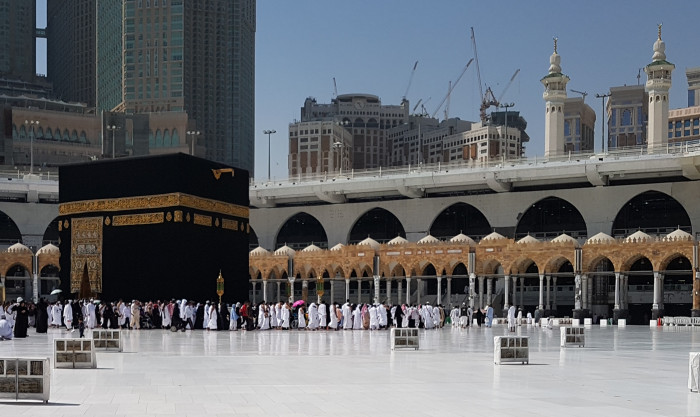The Kaaba, which is in Mecca, Saudi Arabia, is a holy building that is very important to Muslims. It is the centre of the most important religious journey, called Hajj, and has a lot of religious and historical meaning. Even though most people call this sacred place of worship the Kaaba, it is also known by other names that show how important it is from different cultural and spiritual points of view. In this piece, we look at the different names for the Kaaba and explain how this holy place is called by many different names.
Ka'bah:
The most popular and well-known name for the sacred building is "Ka'bah." This name comes from the Arabic word "Ka'bah," which means "cube." It refers to the Kaaba's unique shape as a cube. The word "Ka'bah" describes the shape of the building and makes a clear reference to its well-known look.

Al-Bayt al-Atiq:
"Al-Bayt al-Atiq," which means "The Ancient House" in Arabic, is another name for the Kaaba. This name shows the historical importance of the Kaaba by showing that it has always been there and is linked to Prophet Ibrahim (Abraham) and his son Prophet Ismail (Ishmael). It recognises that the Kaaba has been a sacred place for many generations.
Al-Bayt al-Haram:
"The Sacred House" in Arabic is "Al-Bayt al-Haram," which is another name for the Kaaba. This name emphasises how holy and important the Kaaba is as a place of prayer. It shows that believers think the Kaaba is a holy place where Allah should be worshipped and that it should be treated with the greatest respect and reverence.
Al-Qibla:
"Al-Qibla," which means "The Direction" in Arabic, is the name for the Kaaba. This name shows how important the Kaaba is to Muslims all over the world as the place where they pray. Muslims pray every day facing the Kaaba, no matter where they are in the world. This shows togetherness and a shared focus on Allah.
Al-Masjid al-Haram:
The name "Al-Masjid al-Haram," which means "The Sacred Mosque" in Arabic, is linked to the Kaaba. This name includes not only the Kaaba but also the mosque complex that surrounds it, including the open square and other important parts of the area. Al-Masjid al-Haram is very important because it is the greatest mosque in Islam, and the Kaaba makes it even more spiritually important.
Islam's holiest sanctuary is usually called the Kaaba, but it also has other names that show its religious, historical, and cultural importance. Each name for the Kaaba—Ka'bah, Al-Bayt al-Atiq, Al-Bayt al-Haram, Al-Qibla, or Al-Masjid al-Haram—means something different and makes you think of a different part of its importance. No matter what name is used, the Kaaba is still a symbol for Muslims all over the world of togetherness, devotion, and spiritual connection.
Unveiling the Historical Facts of the Kaaba: Tracing the Sacred Journey through Time
The Kaaba is the holiest place in Islam, and it has a long and interesting past. This holy building in Mecca, Saudi Arabia, has a lot of meaning for Muslims all over the world. The Kaaba is religiously and historically important, and it has a fascinating story that ties together old customs, spiritual history, and Islam's huge effect on the world. In this piece, we look at the history of the Kaaba, including where it came from, how it changed, and why it still stands today.
Ancient Origins:
Origins in the past: The Kaaba has been around for a very long time. Tradition in Islam says that the first person to build the Kaaba was the Prophet Adam (peace be upon him), who is seen as the first human and the first prophet. Over time, the Kaaba was rebuilt several times. The most important ones are said to have been done by the Prophets Ibrahim (Abraham) and Ismail (Ishmael).
Prophetic Connection:
There is a strong link between the Kaaba and the Prophets Ibrahim and Ismail. According to Islamic tradition, Allah told them to rebuild the Kaaba on the grounds that Prophet Adam had set up. The Kaaba became a symbol of monotheism and a central place of worship for followers. This marked the beginning of the Abrahamic faith and laid the groundwork for Islamic practises that would come later.
Before Islam:
The Kaaba was a very important building on the Arabian Peninsula before Islam. It was a place where people from different groups and clans could come together for religious ceremonies and trade. At the time, many people believed in many gods, so the Kaaba was full of idols and other items used for worship. Even though these things happened, the Kaaba still had spiritual and cultural meaning.
Islamic Era:
During the Islamic Era, when Islam and the Prophet Muhammad (peace be upon him) came into being, the Kaaba changed in a big way. Prophet Muhammad, who got messages from Allah, returned the Kaaba to its original, monotheistic purpose. He got rid of the idols that had been put there and made it once again the holy place of worship for Allah alone. This was a very important time in the history of the Kaaba and the beginning of Islam.
Reconstructions and Expansions:
Rebuilding and expanding: Over the course of history, the Kaaba has been rebuilt and enlarged several times to make room for the growing number of visitors. The most important repair happened during the time of the Prophet Muhammad, when he helped rebuild the Kaaba after floods had destroyed it. Muslim leaders and rulers, such as the Umayyads, Abbasids, and Ottomans, added to the building in the years that followed to make room for more believers and make it stronger.
Preservation and Significance:
Preservation and Meaning: Even though time has passed and there have been problems, the Kaaba has been kept as a sign of faith and togetherness. Its importance as the centre of the Hajj journey, one of Islam's Five Pillars, has not changed. Every year, millions of Muslims go to the Kaaba and do the Tawaf, which is a circle around it. This is a way for them to show their faith and connect with their religion's rich spiritual and historical past.
The Kaaba is a symbol of Islam's long history and the strong faith of Muslims all over the world. From its early days as a place of worship to its current role as a central sanctuary, the Kaaba has seen many changes, rebuildings, and additions. It has a special place in the hearts of Muslims because it represents togetherness, devotion, and the fact that people will always be connected to Allah. The history of the Kaaba is fascinating because it shows how Islamic practises have changed over time and how strong faith is.
Read More...
https://webvk.in/unveiling-the-scientific-facts-about-the-kaaba-a-symbol-of-faith-and-wonder/
















